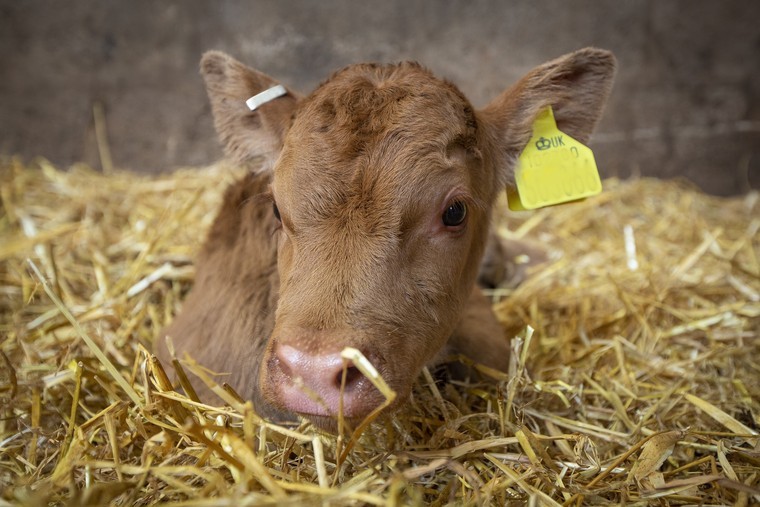BRD (bovine respiratory disease) remains a disease of significant impact across the UK costing the UK cattle industry an estimated £80 million per year1 however recent research2 by Ceva Animal Health has identified aspects of disease identification, management and treatment that could be improved. Moreover, the recent Cattle & Sheep Health & Welfare Survey3 by Ruminant Health and Welfare listed BRD in the top five syndromes affecting cattle production and welfare in the UK.
While the farmers questioned in the research believed that they were quick to identify, diagnose and treat an animal with BRD, which is key to minimising the impact, the disease can be difficult to detect using only visual clinical signs without handling e.g., taking the temperature. Pyrexia (a temperature greater than 39.4ºC) is often the first sign of disease and typically occurs approximately 24 hours (12-72 hours)4, 5 before the more visual clinical signs appear. For the visual clinical signs, the first one is often a nasal discharge which occurs about 24 hours after the increase in temperature. The signs then progress to an increased breathing rate and coughing. Only a quarter of those questioned always took the temperature of an apparently sick calf before medicating, which can be a useful parameter to decide on treatment and monitor during recovery. Encouraging close monitoring of feed intake and demeanour, combined with measuring the temperature, can help in the early identification and appropriate treatment of affected animals.
Viruses are often the initial pathogens before a secondary bacterial infection is established. However, it appears that many farmers were uncertain about the causal pathogens for BRD on their farms, although they did correctly identify external factors such as weather changes, poorly designed or ventilated buildings, and management tasks causing stress. Interestingly, farmers reported rarely isolating sick animals despite two-thirds of those questioned stating that they had a formal written protocol for the treatment of BRD and 69% of vets6 recommending that infected animals are isolated during Herd Health Plan Reviews. In an ideal situation, affected animals would be removed from their pen as well as the common airspace, especially if there are likely to be new (and therefore naïve) animals entering the shed.
When it comes to treatment, antibiotics continue to be a mainstay, and will remain so until detection improves, to treat the primary or secondary bacterial infections. The use of a NSAID, which helps reduce the pyrexia, pain and inflammation associated with disease and therefore improves demeanour and food intake, is generally accepted to be best practice. A quarter of the farmers questioned2 did not use NSAIDs routinely for mild BRD which may delay or complicate the recovery.
There are several NSAIDs available for use in cattle and meloxicam with the benefit of a longer duration of activity is the most commonly used and recommended by cattle vets6. Farmers are advised to consult with their vet as to the most appropriate treatment product for their animals.
Kythé Mackenzie BVSc MRCVS, ruminant veterinary advisor at Ceva Animal Health, comments: “BRD remains a significant health and welfare issue for the UK cattle in both the dairy and beef sectors with the associated decrease in longevity and productivity. It is important vets and farmers work together to put prevention and management protocols in place. When treatment is necessary the inclusion of a NSAID has recognised benefits especially in the reduction of pyrexia and pain.”
Top tips to help prevent, identify and manage BRD on farms:
- Ensure the herd’s vaccination plan is up to date and completed as per your vet’s instructions
- Make sure calves receive sufficient, high-quality colostrum within four to six hours of birth to provide passive transfer of antibodies
- Reduce stress associated with management procedures such as disbudding and transport
- Make sure the housing has the best ventilation possible and minimise the mixing of age groups to help reduce the risk of disease
- Take the temperature as soon as there are concerns that BRD may be developing. A high temperature is often the first sign of BRD and can be a useful factor in deciding the best treatment for each case, as well as being a useful parameter to monitor during recovery. A calf with BRD will often have a rectal temperature of more than 39.4C which may be seen before other more obvious clinical signs such as: nasal discharge, reduced feed intake and coughing
- Seek veterinary advice on whether it may be worth taking diagnostic samples to guide treatment protocols, as well as future vaccination plans
- Use of a NSAID when treating helps reduce the high temperature, pain and inflammation associated with BRD which will lead to improved demeanour and food intake
- Ideally, remove affected animals from their pen and the common airspace of other calves, especially if there are likely to be new (and therefore naïve) animals entering the shed
- If the affected animal cannot be removed from the common airspace it is still advisable to consider moving the affected animal(s) out of the pen to prevent physical contact and closely monitor both the affected animal and its cohort
- These hospital pens allow better monitoring of the sick calves. For example, the monitoring of food intake and response to treatment. Always consider if movement to an isolation or sick pen will increase stress as this may be less appropriate
- Wherever the animals are housed, good ventilation with a clean, dry bed are essential for prevention and recovery. It is also advisable to clean and disinfect feeding equipment
Ceva Animal Health has launched a ‘Breathe and feel better’ marketing campaign to promote best practice amongst farmers to help identify, manage and treat BRD on farms.




